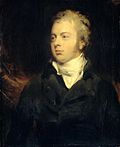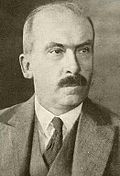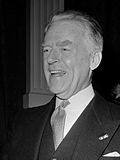De Nederlandsche Bank
52°21′31.40″N 4°54′0.0″E / 52.3587222°N 4.900000°E
 | |
 | |
| Headquarters | Amsterdam |
|---|---|
| Established | 25 March 1814 |
| President | Klaas Knot |
| Central bank of | the Netherlands |
| Reserves | 8 840 million USD[1] |
| Succeeded by | European Central Bank (1999)1 |
| Website | dnb |
| 1 De Nederlandsche Bank still exists but many functions have been taken over by the ECB. | |
De Nederlandsche Bank (DNB, lit. 'The Dutch Bank') is the Dutch member of the Eurosystem and has been the monetary authority for the Netherlands from 1814 to 1998, issuing the Dutch guilder. Since 2014, it has also been the country's national competent authority within European Banking Supervision.[2] It was originally founded by King William I, and has been since transformed into a state-owned public limited company (Dutch: naamloze vennootschap, abbreviated NV).
History
[edit]On 2 May 1998, the European heads of state or government decided that the Economic and Monetary Union (EMU) would begin on 1 January 1999 with eleven member states of the European Union (EU), the Netherlands included. As from 1 June 1998, the Dutch central bank, De Nederlandsche Bank N.V., forms part of the European System of Central Banks (ESCB). On the same day, the new Bank Act (of 1998) came into force. Nearly 185 years into its existence, the Nederlandsche Bank has entered a new phase.
Tasks
[edit]Under the 1998 Bank Act – replacing that of 1948 – the bank has the following tasks:
- Within the framework of the ESCB, the bank shall contribute to the definition and implementation of monetary policy within the European Community (EC). The bank has the objective to maintain price stability. Without prejudice to this objective, the bank shall support the general economic policy in the EC.
- The bank shall hold and manage the official foreign reserves, and shall conduct foreign-exchange operations.
- The bank shall collect statistical data and produce statistics.
- The bank shall promote the smooth operation of payment systems; it shall take care of the banknote circulation.
- The bank shall supervise banks, investment institutions and exchange offices.
- The bank may, subject to permission by royal decree, perform other tasks in the public interest. The European Central Bank (ECB) may also ask the bank to perform extra tasks.
The first two tasks – also known as the ESCB tasks – ensue entirely from the Maastricht Treaty. Decisions in these areas are taken at the European level by the ECB Governing Council, on which the president of the Nederlandsche Bank has a seat. Promoting the smooth operation of payment systems has both a European and a national dimension. The statistical task is also partly ESCB-related and partly a national concern. The DNB is responsible for international macro-economic statistical analysis for countries outside the EU.[3] These two tasks will not be transferred to ESCB level at the start of EMU. Here the Nederlandsche Bank remains fully in control. However, in a Europe where economies are becoming increasingly interlocked, many banking supervisory rules are drawn up at the international level. DNB serves as the banker's bank to general Dutch banks.
One of the government appointed members of the Social-Economic Council is always a representative of DNB.
Head office
[edit]The bank was established from the start on Oude Turfmarkt, where it occupied 17th-century houses. In the 1860s, a purpose-built head office, designed by architect Willem Anthonie Froger, was erected on the same location and inaugurated in 1869. Nearly a century later in 1968, as the bank has left the building for its new seat, it was taken over by the University of Amsterdam which had long been established just nearby, and subsequently repurposed as the location of the Allard Pierson Museum, which opened there in October 1976.[4]
In the 1960s, a new head office complex was constructed on Frederiksplein and inaugurated by Queen Juliana in May 1968. Architect Marius Duintjer's stark design of 1961 consisted on a low square base and a rectangular office tower. In the late 1980s, as the bank was running out of space, it was complemented with a second, oval tower designed in 1984 by architects Jelle Abma and Marc a Campo, whose construction was finished in 1989. In 2008, Marc a Campo designed a further extension by adding an extra floor to the square base. In a comprehensive renovation during the early 2020s, the oval tower was demolished and the base remodeled to return the building to an exterior appearance more similar to the original one of the 1960s.[5]
-
DNB head office at time of inauguration, 1869
-
Old head office in 2006, repurposed as Allard Pierson Museum
-
Construction works, 1963
-
New head office complex, 1967
-
Construction of oval tower, 1989
-
Late-1980s extension, photographed in 2004
-
Street-level fence, 2018
List of presidents
[edit]See also
[edit]- Economy of the Netherlands
- Central Bank of Curaçao and Sint Maarten
- Central Bank of Aruba
- Bank of Java
- Netherlands Authority for the Financial Markets
- List of central banks
References
[edit]- ^ Weidner, Jan (2017). "The Organisation and Structure of Central Banks" (PDF). Katalog der Deutschen Nationalbibliothek.
- ^ "National supervisors". ECB Banking Supervision.
- ^ Ahmed, Asif (2 July 2010). "Analysis of the Mission Statement of the Commercial Banks of Bangladesh". SSRN 1633225.
- ^ "Our Buildings". Allard Pierson Museum.
- ^ "Renovation of DNB's head office". De Nederlandsche Bank.
External links
[edit]- Government-owned companies of the Netherlands
- Banks based in Amsterdam
- Skyscrapers in Amsterdam
- European System of Central Banks
- Eurosystem
- Central banks
- Banks established in 1814
- 1814 establishments in the Netherlands
- Financial regulatory authorities of the Netherlands
- European Banking Supervision
- European Single Resolution Mechanism

















